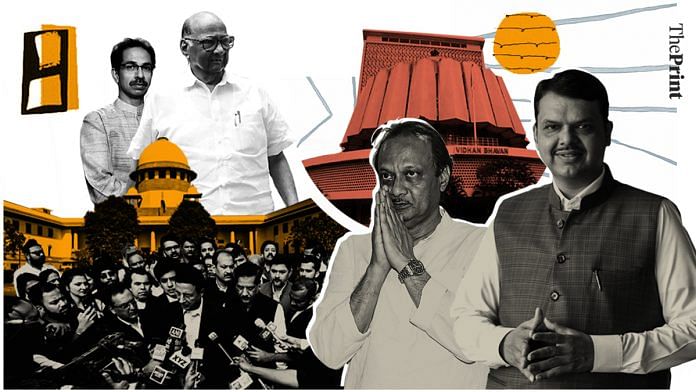The Supreme Court said it will Tuesday announce its order on the petition filed by Shiv Sena, NCP and Congress demanding a floor test in the Maharashtra assembly. Two days after BJP’s Devendra Fadnavis was sworn in as the CM, the government’s fate hangs in the balance. A similar crisis had played out earlier in Karnataka and Goa.
ThePrint asks: Maharashtra govt crisis: Should there be a fixed deadline for floor tests after swearing-in?
Giving governors all the authority hasn’t worked. Perhaps it’s time to rethink their powers
 Arghya Sengupta
Arghya Sengupta
Founder and director, Vidhi Centre for Legal Policy
What is happening in Maharashtra is more a question of common sense than a question of law. If any political party, irrespective of its ideology, has staked the claim to form a government, then the governor should invite that party as soon as possible to make good on that claim. A floor test in the House should happen within a reasonably practical time frame. I think it could be one or two days after the political party has staked its claim to form the government. This should be sufficient. There is no ostensible reason why it should take any longer.
There have been several instances in the last two decades when the role of the governor has come under serious scrutiny – mainly the basis on which they have made their decisions. It seems that empowering the governor with the authority to take a call on government formation – in terms of which party to invite and how much time to give it to prove majority – hasn’t really worked towards ensuring justice is done, which is what was originally envisaged.
In every instance of hung assembly or in the absence of a clear coalition, the matter ends up in the Supreme Court. It is perhaps time to rethink the powers of the governor.
Supreme Court’s intervention brought the rule of floor test but judiciary still silent on two crucial points
 Alok Prasanna
Alok Prasanna
Senior resident fellow, Vidhi Centre for Legal Policy
The hope that the governors will act in accordance with the Constitution on government formation was dashed right at the beginning by Congress-appointed governors like Sri Prakasa. They used the Constitution’s silence to get around the requirement of inviting the single-largest party or coalition to form the government and allowed all sorts of unethical practices.
The only scrutiny on the governors has come in recent times from the Supreme Court, which has had to intervene and go beyond its remit to ensure that the basic constitutional norms are followed in government formation. The innovation of a “floor test” as a matter of rule came about due to this intervention.
However, courts have not been able to give clarity on two important issues. First, in case of a hung assembly, who should be invited first to form a government; and second, how much time should be given to them to form the government.
Trying to answer the question of a time limit for a floor test will only touch upon the symptom and ignore the deeper problem – namely, governors behaving like the agents of the Union government and acting in a partisan manner. Unless the manner in which the governors are appointed is fundamentally changed, attempts to curtail unethical practices through minor changes in rules will not help.
Also read: Only reason why Amit Shah & Ajit Pawar enacted midnight Maharashtra drama — opposition sloth
Immediate floor test without governor or SC’s discretion will let Indian institutions avoid crises of legitimacy
 Neelanjan Sircar
Neelanjan Sircar
Senior visiting fellow, CPR
The power-hungry rarely care about the legitimacy of the country’s institutions. It does not matter what your political persuasion is, when you look at Karnataka or Maharashtra, you find that the role of the governor, the Supreme Court, and the parliamentary norms have all become a farce. One side or the other may have won the battle for power, but immeasurable damage has been done to the credibility of democratic institutions in India in the eyes of the people.
There is no good reason why floor tests should not take place immediately, regardless of the political party or leader staking claim to form the government. By allowing for “time” to prove one’s majority, the Supreme Court has time and time again given incentives to buy off corrupt legislators. Given the scale of dirty money in Indian politics, this is a genuine fear.
Enforcing an immediate floor test (or a short, fixed window within which one must be taken), without the discretion of the governor or the Supreme Court, would allow India’s institutions to avoid these crises of legitimacy. This political moment will pass, as they all do. But the stink of alleged political manipulation of India’s bureaucratic and judicial institutions in government formation will continue to follow these institutions for much longer.
Governors should ensure governments are formed as quickly as possible. A rapid floor test is indispensable
 Balveer Arora
Balveer Arora
Chairman, Centre for Multilevel Federalism
The procedure to be followed by governors in the case of competing claims to form a government, either after an election or after the fall of a government, is by now well established in numerous cases settled by the judiciary.
The first principle is that the majority has to be proved not to the governor, but on the floor of the House. The second is that it has to be proved within a time frame laid down by the governor. The idea that a short time frame prevents horse-trading and is democratically desirable is generally accepted by all parties. So, the governor would be well advised to not give a longer time frame to the political parties to prove majority. In fact, the governor’s aim should be to complete the exercise as quickly as possible.
In the interest of democracy and in keeping with the high principle enunciated by both President Ram Nath Kovind and Prime Minister Narendra Modi in the recently concluded governors’ conference, it would be fitting of Maharashtra governor Bhagat Singh Koshyari to act according to both constitutional morality and democratic legitimacy. A rapid floor test is indispensable.
Supreme Court must now fix rules & procedure to guide various players, including Governor and Speaker
 Maneesh Chhibber
Maneesh Chhibber
Senior columnist
In recent politically-sensitive cases, especially those in which the BJP is a party, the scales of justice seem to have tilted in favour of the BJP.
In states where voters give a fractured mandate, the matter of government formation invariably reaches the Supreme Court, which is then expected to play the referee. Maharashtra is no exception.
Since the political class has consigned constitutional morality to the dustbin, it is for the country’s top constitutional court to now fix rules and procedure to guide various players, including the Governor and the Speaker.
To begin with, whenever the Governor invites the leader of a party or a coalition to form the government, there must be a fixed deadline for floor tests after the swearing-in.
And, to ensure a level-playing field, the deadline should be the same in all cases, whether the government is of the BJP or the Congress or any other party. Equally important is the need to ensure that this deadline limits, if not completely eliminates, the possibility of horse-trading of elected legislators.
Operation Lotus or any other such operation, which is clearly aimed at horse-trading, is possible due to the questionable legroom granted to the chief minister to prove his majority on the floor of the house.
Also read: Whether it’s CM Fadnavis or CM Thackeray, the only winner in Maharashtra is Rahul Gandhi
By Taran Deol, journalist at ThePrint




The role of governor/president in govt formation must be completely eliminated. There must be a clear process that can take care of all the possible scenarios and that is not as difficult as is made out by some. After all, we as an electoral system have enough experience by now to be able to take care of all the possible scenarios. The best way is for the assembly/lok sabha to convene immediately after the election results are formally declared by the EC. Then a free election of the CM/PM can be conducted in the house. Once the CM/PM is elected, s/he should be free to form a cabinet as per his will and political/administrative convenience. His cabinet members may be from any party or even independents. The incumbent govt’s bills may get passed or rejected frrom time to time depnding on the support that the govt can muster in the house at the time. A govt can fall only if a no-confidence motion is passed with 2/3 majority. Then a new CM/PM should be elected.
All the above suggestions are based on the assumption that human being are like machines and laying down with rules will fix all problems just like computer rules. However, Democracy being human based , is an organic activity, all rules will be circumvented if needed. Everyone new situation arise there will be demand for new rules. It will create new class who only will be able to decipher the rules. So solutions are not in rules but to educate both people and their representatives. It is long journey but forming convensions is both desirable and easier.
Another option would be for the invitation to form a government to be extended only after the claimant submits letters of support from a majority of the newly elected legislators. That would convert the subsequent vote of confidence into a formality. 2. At such an exalted level, this should not really be necessary. However, prudence requires that the letters of support be verified by the Governor’s office. That would avoid the contingency of signatures tendered for an entirely different object being used to substantiate a letter of support.
In the normal course, there is no rush. Members are to be sworn in, the Speaker elected, the majesty of government formation not clouded by unseemly haste. However, in a sharply contested situation, any delay in proving majority support on the floor of the House is to throw the field open to the horse whisperers. After the apex court’s intervention in Karnataka, there is no propriety in allowing a period of fourteen days. Or or two days at the most.